Organisational Behaviour: Analysing Influence of Culture at Tesco
VerifiedAdded on 2023/06/07
|14
|4993
|171
Report
AI Summary
This report provides an analysis of organisational behaviour, focusing on how culture, politics, and power influence individual and team performance, using Tesco as a case study. It examines various cultural types within Tesco, such as task, power, person, and role cultures, and discusses the impact of organisational politics on employee motivation and productivity. The report also explores different forms of power, including legitimate, reward, referent, and informational power, and their application within Tesco's leadership. Furthermore, it evaluates content and process theories of motivation and their role in achieving organisational goals, discusses the characteristics of effective and ineffective teams, and applies organisational behaviour concepts and philosophies to a specific business situation within Tesco. The report concludes by emphasising the importance of managing culture, politics, and power to enhance organisational performance.
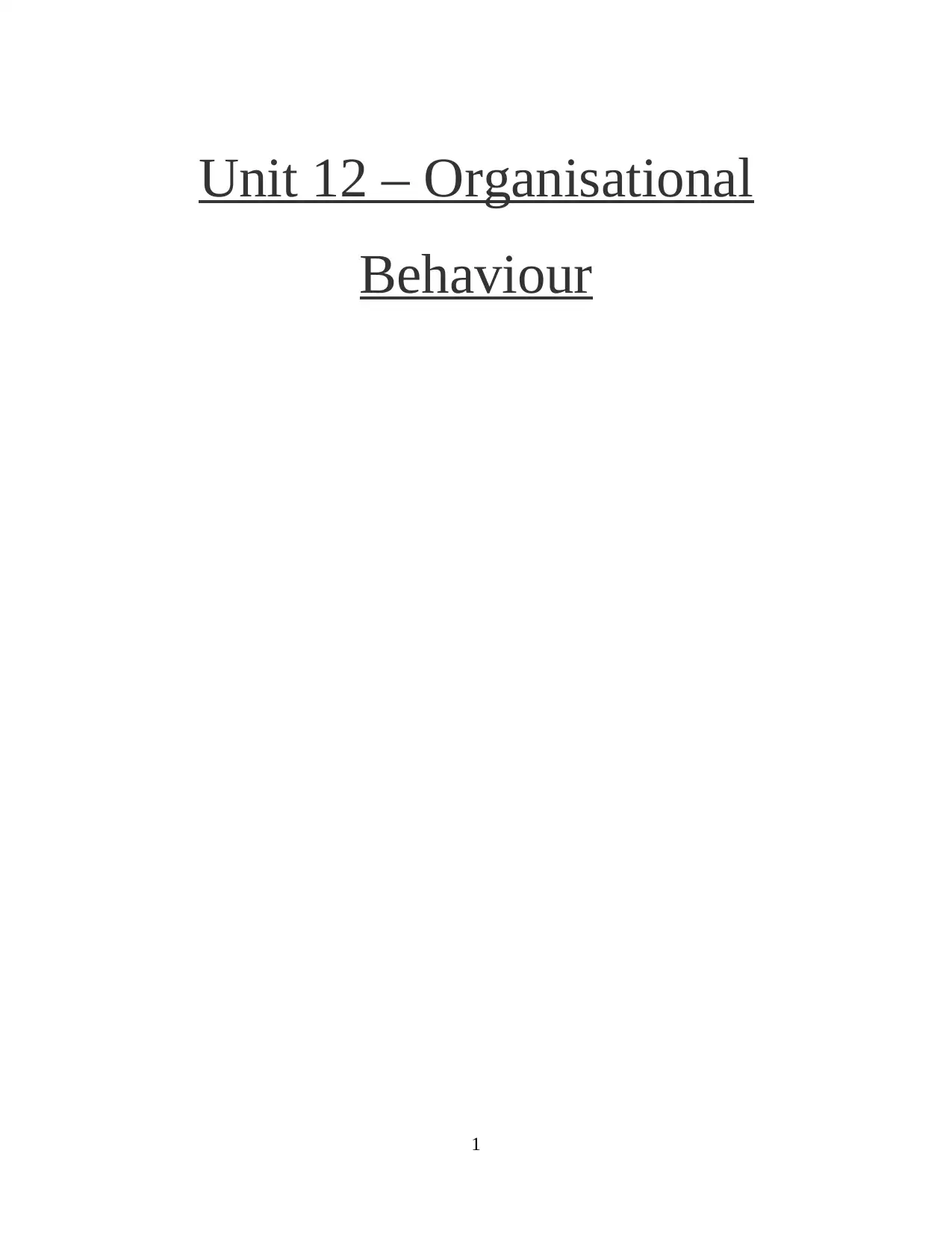
Unit 12 – Organisational
Behaviour
1
Behaviour
1
Paraphrase This Document
Need a fresh take? Get an instant paraphrase of this document with our AI Paraphraser
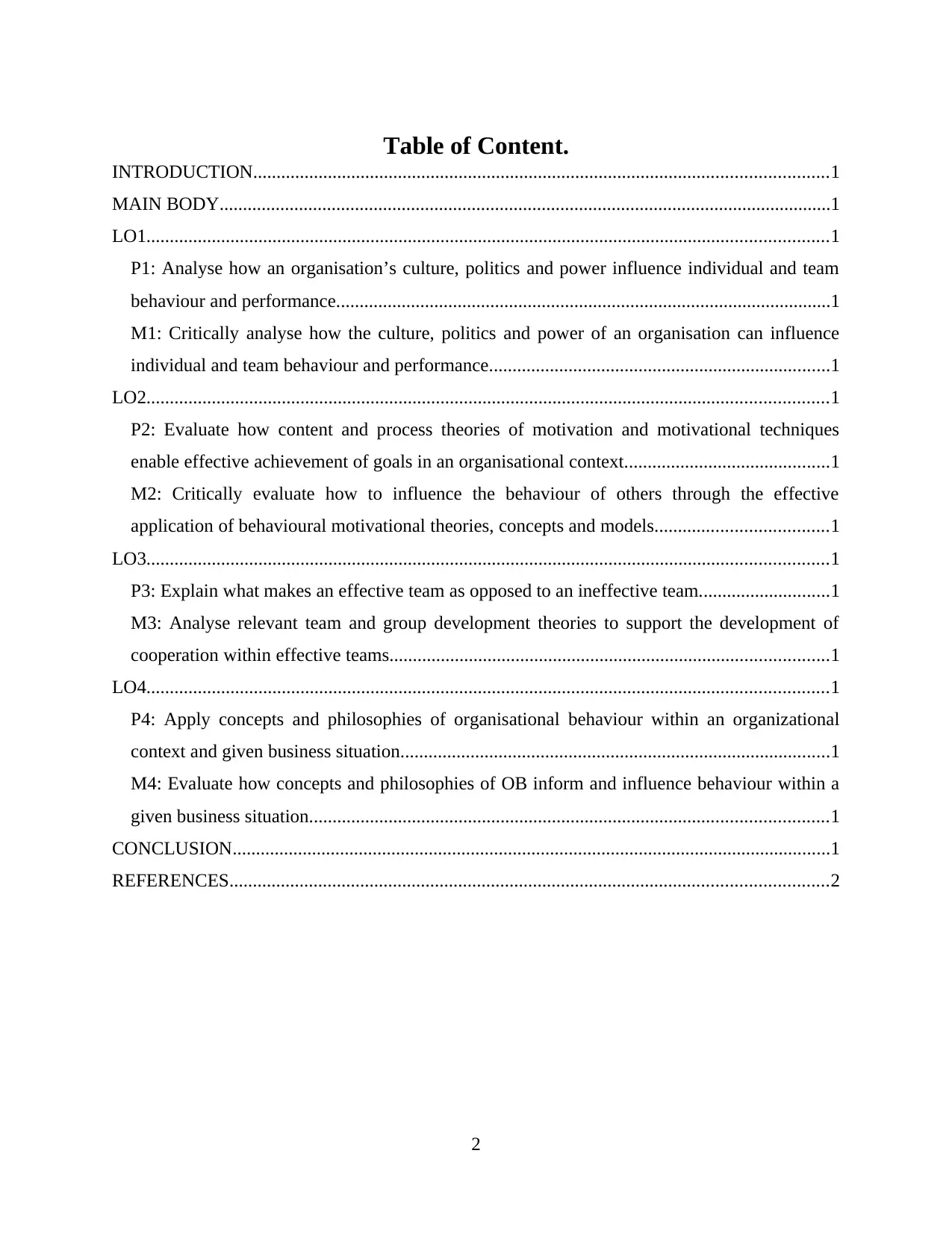
Table of Content.
INTRODUCTION...........................................................................................................................1
MAIN BODY...................................................................................................................................1
LO1..................................................................................................................................................1
P1: Analyse how an organisation’s culture, politics and power influence individual and team
behaviour and performance..........................................................................................................1
M1: Critically analyse how the culture, politics and power of an organisation can influence
individual and team behaviour and performance.........................................................................1
LO2..................................................................................................................................................1
P2: Evaluate how content and process theories of motivation and motivational techniques
enable effective achievement of goals in an organisational context............................................1
M2: Critically evaluate how to influence the behaviour of others through the effective
application of behavioural motivational theories, concepts and models.....................................1
LO3..................................................................................................................................................1
P3: Explain what makes an effective team as opposed to an ineffective team............................1
M3: Analyse relevant team and group development theories to support the development of
cooperation within effective teams..............................................................................................1
LO4..................................................................................................................................................1
P4: Apply concepts and philosophies of organisational behaviour within an organizational
context and given business situation............................................................................................1
M4: Evaluate how concepts and philosophies of OB inform and influence behaviour within a
given business situation...............................................................................................................1
CONCLUSION................................................................................................................................1
REFERENCES................................................................................................................................2
2
INTRODUCTION...........................................................................................................................1
MAIN BODY...................................................................................................................................1
LO1..................................................................................................................................................1
P1: Analyse how an organisation’s culture, politics and power influence individual and team
behaviour and performance..........................................................................................................1
M1: Critically analyse how the culture, politics and power of an organisation can influence
individual and team behaviour and performance.........................................................................1
LO2..................................................................................................................................................1
P2: Evaluate how content and process theories of motivation and motivational techniques
enable effective achievement of goals in an organisational context............................................1
M2: Critically evaluate how to influence the behaviour of others through the effective
application of behavioural motivational theories, concepts and models.....................................1
LO3..................................................................................................................................................1
P3: Explain what makes an effective team as opposed to an ineffective team............................1
M3: Analyse relevant team and group development theories to support the development of
cooperation within effective teams..............................................................................................1
LO4..................................................................................................................................................1
P4: Apply concepts and philosophies of organisational behaviour within an organizational
context and given business situation............................................................................................1
M4: Evaluate how concepts and philosophies of OB inform and influence behaviour within a
given business situation...............................................................................................................1
CONCLUSION................................................................................................................................1
REFERENCES................................................................................................................................2
2
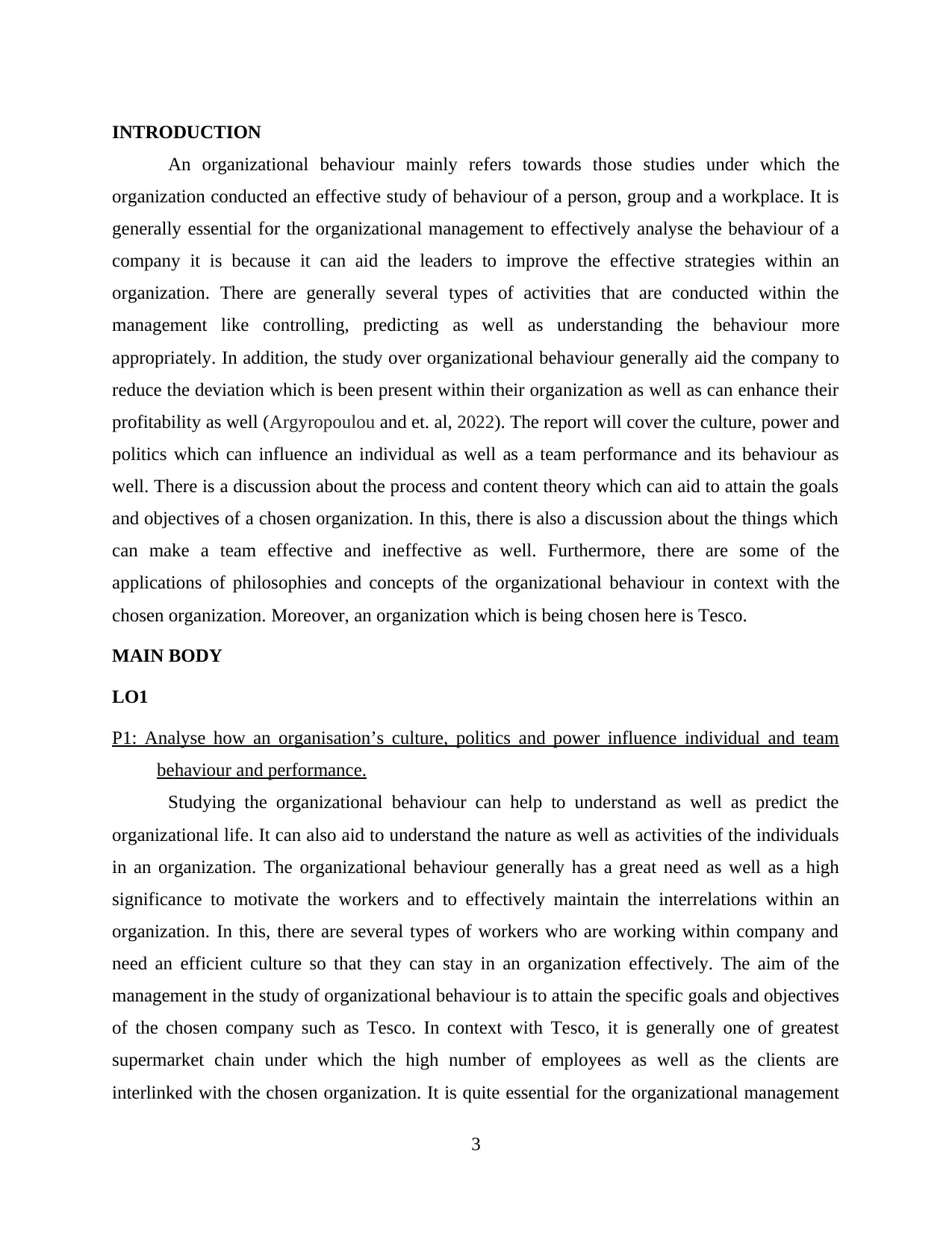
INTRODUCTION
An organizational behaviour mainly refers towards those studies under which the
organization conducted an effective study of behaviour of a person, group and a workplace. It is
generally essential for the organizational management to effectively analyse the behaviour of a
company it is because it can aid the leaders to improve the effective strategies within an
organization. There are generally several types of activities that are conducted within the
management like controlling, predicting as well as understanding the behaviour more
appropriately. In addition, the study over organizational behaviour generally aid the company to
reduce the deviation which is been present within their organization as well as can enhance their
profitability as well (Argyropoulou and et. al, 2022). The report will cover the culture, power and
politics which can influence an individual as well as a team performance and its behaviour as
well. There is a discussion about the process and content theory which can aid to attain the goals
and objectives of a chosen organization. In this, there is also a discussion about the things which
can make a team effective and ineffective as well. Furthermore, there are some of the
applications of philosophies and concepts of the organizational behaviour in context with the
chosen organization. Moreover, an organization which is being chosen here is Tesco.
MAIN BODY
LO1
P1: Analyse how an organisation’s culture, politics and power influence individual and team
behaviour and performance.
Studying the organizational behaviour can help to understand as well as predict the
organizational life. It can also aid to understand the nature as well as activities of the individuals
in an organization. The organizational behaviour generally has a great need as well as a high
significance to motivate the workers and to effectively maintain the interrelations within an
organization. In this, there are several types of workers who are working within company and
need an efficient culture so that they can stay in an organization effectively. The aim of the
management in the study of organizational behaviour is to attain the specific goals and objectives
of the chosen company such as Tesco. In context with Tesco, it is generally one of greatest
supermarket chain under which the high number of employees as well as the clients are
interlinked with the chosen organization. It is quite essential for the organizational management
3
An organizational behaviour mainly refers towards those studies under which the
organization conducted an effective study of behaviour of a person, group and a workplace. It is
generally essential for the organizational management to effectively analyse the behaviour of a
company it is because it can aid the leaders to improve the effective strategies within an
organization. There are generally several types of activities that are conducted within the
management like controlling, predicting as well as understanding the behaviour more
appropriately. In addition, the study over organizational behaviour generally aid the company to
reduce the deviation which is been present within their organization as well as can enhance their
profitability as well (Argyropoulou and et. al, 2022). The report will cover the culture, power and
politics which can influence an individual as well as a team performance and its behaviour as
well. There is a discussion about the process and content theory which can aid to attain the goals
and objectives of a chosen organization. In this, there is also a discussion about the things which
can make a team effective and ineffective as well. Furthermore, there are some of the
applications of philosophies and concepts of the organizational behaviour in context with the
chosen organization. Moreover, an organization which is being chosen here is Tesco.
MAIN BODY
LO1
P1: Analyse how an organisation’s culture, politics and power influence individual and team
behaviour and performance.
Studying the organizational behaviour can help to understand as well as predict the
organizational life. It can also aid to understand the nature as well as activities of the individuals
in an organization. The organizational behaviour generally has a great need as well as a high
significance to motivate the workers and to effectively maintain the interrelations within an
organization. In this, there are several types of workers who are working within company and
need an efficient culture so that they can stay in an organization effectively. The aim of the
management in the study of organizational behaviour is to attain the specific goals and objectives
of the chosen company such as Tesco. In context with Tesco, it is generally one of greatest
supermarket chain under which the high number of employees as well as the clients are
interlinked with the chosen organization. It is quite essential for the organizational management
3
⊘ This is a preview!⊘
Do you want full access?
Subscribe today to unlock all pages.

Trusted by 1+ million students worldwide
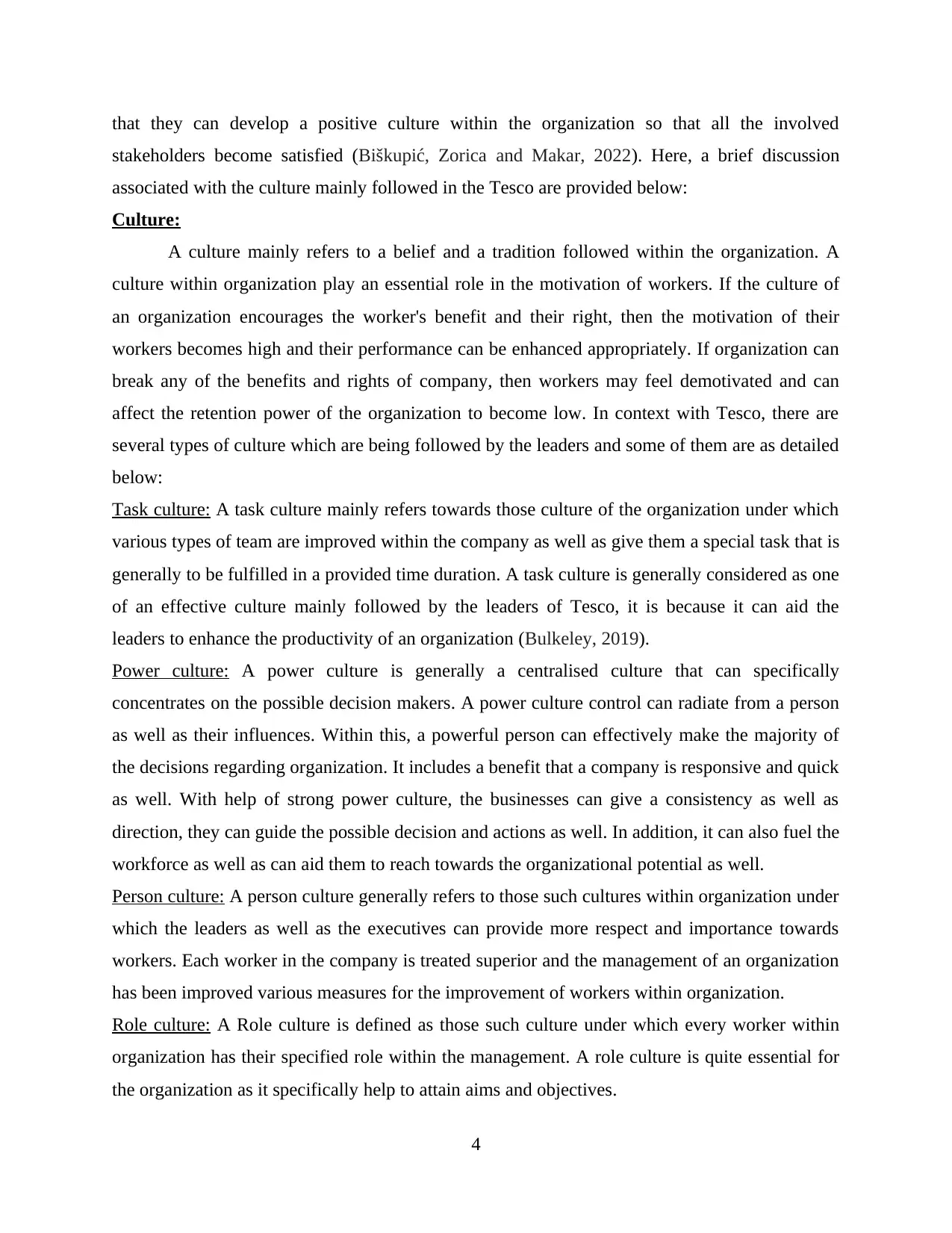
that they can develop a positive culture within the organization so that all the involved
stakeholders become satisfied (Biškupić, Zorica and Makar, 2022). Here, a brief discussion
associated with the culture mainly followed in the Tesco are provided below:
Culture:
A culture mainly refers to a belief and a tradition followed within the organization. A
culture within organization play an essential role in the motivation of workers. If the culture of
an organization encourages the worker's benefit and their right, then the motivation of their
workers becomes high and their performance can be enhanced appropriately. If organization can
break any of the benefits and rights of company, then workers may feel demotivated and can
affect the retention power of the organization to become low. In context with Tesco, there are
several types of culture which are being followed by the leaders and some of them are as detailed
below:
Task culture: A task culture mainly refers towards those culture of the organization under which
various types of team are improved within the company as well as give them a special task that is
generally to be fulfilled in a provided time duration. A task culture is generally considered as one
of an effective culture mainly followed by the leaders of Tesco, it is because it can aid the
leaders to enhance the productivity of an organization (Bulkeley, 2019).
Power culture: A power culture is generally a centralised culture that can specifically
concentrates on the possible decision makers. A power culture control can radiate from a person
as well as their influences. Within this, a powerful person can effectively make the majority of
the decisions regarding organization. It includes a benefit that a company is responsive and quick
as well. With help of strong power culture, the businesses can give a consistency as well as
direction, they can guide the possible decision and actions as well. In addition, it can also fuel the
workforce as well as can aid them to reach towards the organizational potential as well.
Person culture: A person culture generally refers to those such cultures within organization under
which the leaders as well as the executives can provide more respect and importance towards
workers. Each worker in the company is treated superior and the management of an organization
has been improved various measures for the improvement of workers within organization.
Role culture: A Role culture is defined as those such culture under which every worker within
organization has their specified role within the management. A role culture is quite essential for
the organization as it specifically help to attain aims and objectives.
4
stakeholders become satisfied (Biškupić, Zorica and Makar, 2022). Here, a brief discussion
associated with the culture mainly followed in the Tesco are provided below:
Culture:
A culture mainly refers to a belief and a tradition followed within the organization. A
culture within organization play an essential role in the motivation of workers. If the culture of
an organization encourages the worker's benefit and their right, then the motivation of their
workers becomes high and their performance can be enhanced appropriately. If organization can
break any of the benefits and rights of company, then workers may feel demotivated and can
affect the retention power of the organization to become low. In context with Tesco, there are
several types of culture which are being followed by the leaders and some of them are as detailed
below:
Task culture: A task culture mainly refers towards those culture of the organization under which
various types of team are improved within the company as well as give them a special task that is
generally to be fulfilled in a provided time duration. A task culture is generally considered as one
of an effective culture mainly followed by the leaders of Tesco, it is because it can aid the
leaders to enhance the productivity of an organization (Bulkeley, 2019).
Power culture: A power culture is generally a centralised culture that can specifically
concentrates on the possible decision makers. A power culture control can radiate from a person
as well as their influences. Within this, a powerful person can effectively make the majority of
the decisions regarding organization. It includes a benefit that a company is responsive and quick
as well. With help of strong power culture, the businesses can give a consistency as well as
direction, they can guide the possible decision and actions as well. In addition, it can also fuel the
workforce as well as can aid them to reach towards the organizational potential as well.
Person culture: A person culture generally refers to those such cultures within organization under
which the leaders as well as the executives can provide more respect and importance towards
workers. Each worker in the company is treated superior and the management of an organization
has been improved various measures for the improvement of workers within organization.
Role culture: A Role culture is defined as those such culture under which every worker within
organization has their specified role within the management. A role culture is quite essential for
the organization as it specifically help to attain aims and objectives.
4
Paraphrase This Document
Need a fresh take? Get an instant paraphrase of this document with our AI Paraphraser
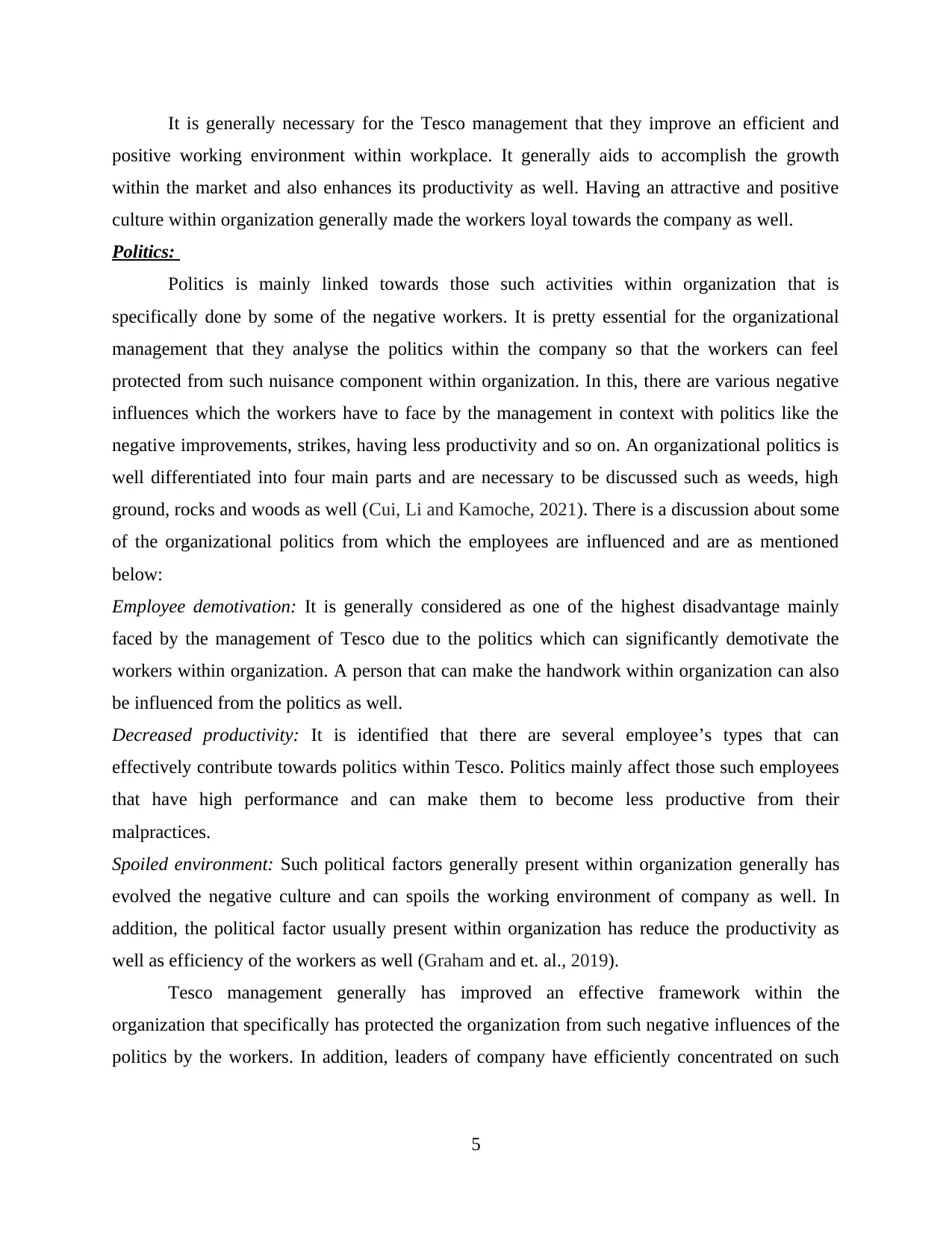
It is generally necessary for the Tesco management that they improve an efficient and
positive working environment within workplace. It generally aids to accomplish the growth
within the market and also enhances its productivity as well. Having an attractive and positive
culture within organization generally made the workers loyal towards the company as well.
Politics:
Politics is mainly linked towards those such activities within organization that is
specifically done by some of the negative workers. It is pretty essential for the organizational
management that they analyse the politics within the company so that the workers can feel
protected from such nuisance component within organization. In this, there are various negative
influences which the workers have to face by the management in context with politics like the
negative improvements, strikes, having less productivity and so on. An organizational politics is
well differentiated into four main parts and are necessary to be discussed such as weeds, high
ground, rocks and woods as well (Cui, Li and Kamoche, 2021). There is a discussion about some
of the organizational politics from which the employees are influenced and are as mentioned
below:
Employee demotivation: It is generally considered as one of the highest disadvantage mainly
faced by the management of Tesco due to the politics which can significantly demotivate the
workers within organization. A person that can make the handwork within organization can also
be influenced from the politics as well.
Decreased productivity: It is identified that there are several employee’s types that can
effectively contribute towards politics within Tesco. Politics mainly affect those such employees
that have high performance and can make them to become less productive from their
malpractices.
Spoiled environment: Such political factors generally present within organization generally has
evolved the negative culture and can spoils the working environment of company as well. In
addition, the political factor usually present within organization has reduce the productivity as
well as efficiency of the workers as well (Graham and et. al., 2019).
Tesco management generally has improved an effective framework within the
organization that specifically has protected the organization from such negative influences of the
politics by the workers. In addition, leaders of company have efficiently concentrated on such
5
positive working environment within workplace. It generally aids to accomplish the growth
within the market and also enhances its productivity as well. Having an attractive and positive
culture within organization generally made the workers loyal towards the company as well.
Politics:
Politics is mainly linked towards those such activities within organization that is
specifically done by some of the negative workers. It is pretty essential for the organizational
management that they analyse the politics within the company so that the workers can feel
protected from such nuisance component within organization. In this, there are various negative
influences which the workers have to face by the management in context with politics like the
negative improvements, strikes, having less productivity and so on. An organizational politics is
well differentiated into four main parts and are necessary to be discussed such as weeds, high
ground, rocks and woods as well (Cui, Li and Kamoche, 2021). There is a discussion about some
of the organizational politics from which the employees are influenced and are as mentioned
below:
Employee demotivation: It is generally considered as one of the highest disadvantage mainly
faced by the management of Tesco due to the politics which can significantly demotivate the
workers within organization. A person that can make the handwork within organization can also
be influenced from the politics as well.
Decreased productivity: It is identified that there are several employee’s types that can
effectively contribute towards politics within Tesco. Politics mainly affect those such employees
that have high performance and can make them to become less productive from their
malpractices.
Spoiled environment: Such political factors generally present within organization generally has
evolved the negative culture and can spoils the working environment of company as well. In
addition, the political factor usually present within organization has reduce the productivity as
well as efficiency of the workers as well (Graham and et. al., 2019).
Tesco management generally has improved an effective framework within the
organization that specifically has protected the organization from such negative influences of the
politics by the workers. In addition, leaders of company have efficiently concentrated on such
5
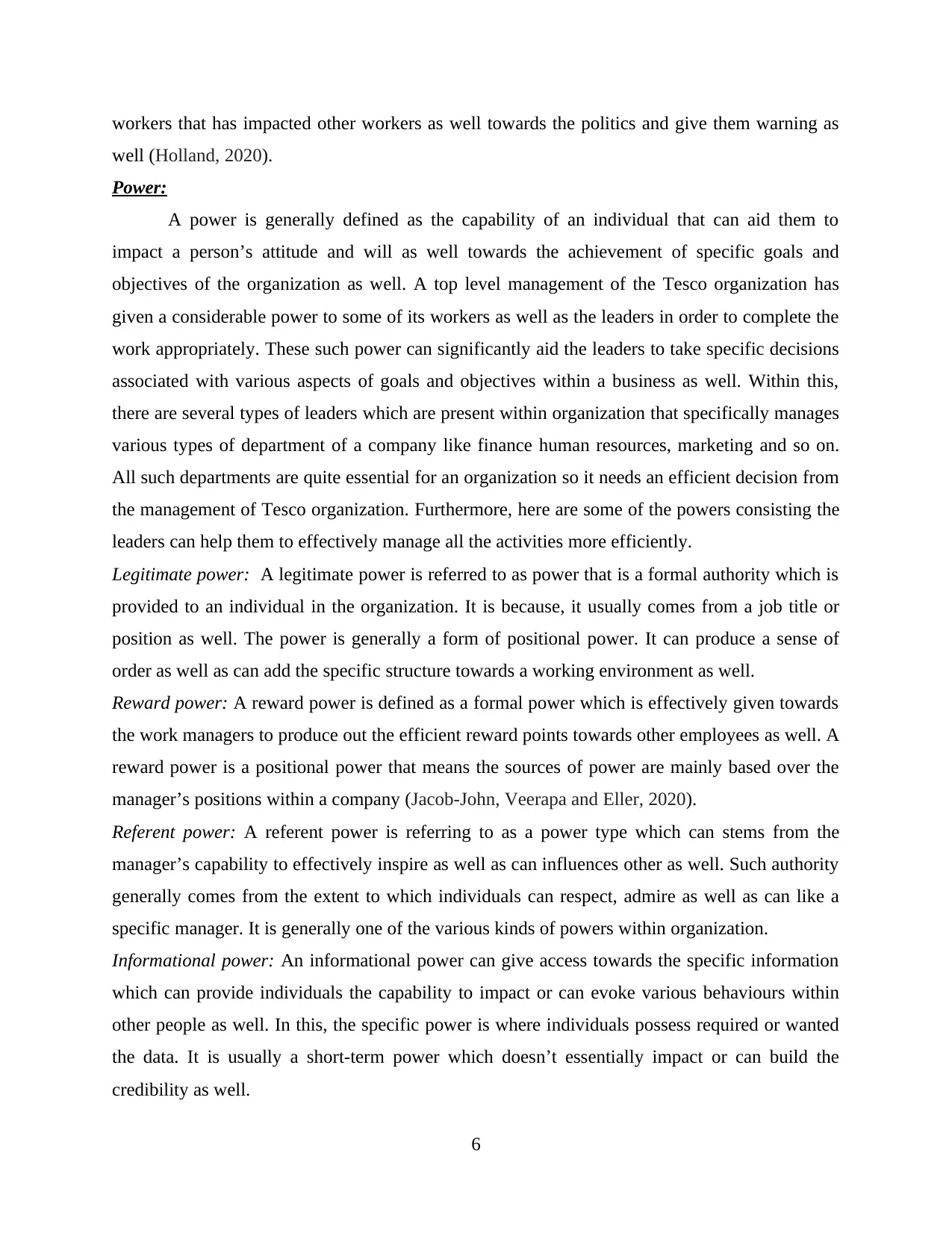
workers that has impacted other workers as well towards the politics and give them warning as
well (Holland, 2020).
Power:
A power is generally defined as the capability of an individual that can aid them to
impact a person’s attitude and will as well towards the achievement of specific goals and
objectives of the organization as well. A top level management of the Tesco organization has
given a considerable power to some of its workers as well as the leaders in order to complete the
work appropriately. These such power can significantly aid the leaders to take specific decisions
associated with various aspects of goals and objectives within a business as well. Within this,
there are several types of leaders which are present within organization that specifically manages
various types of department of a company like finance human resources, marketing and so on.
All such departments are quite essential for an organization so it needs an efficient decision from
the management of Tesco organization. Furthermore, here are some of the powers consisting the
leaders can help them to effectively manage all the activities more efficiently.
Legitimate power: A legitimate power is referred to as power that is a formal authority which is
provided to an individual in the organization. It is because, it usually comes from a job title or
position as well. The power is generally a form of positional power. It can produce a sense of
order as well as can add the specific structure towards a working environment as well.
Reward power: A reward power is defined as a formal power which is effectively given towards
the work managers to produce out the efficient reward points towards other employees as well. A
reward power is a positional power that means the sources of power are mainly based over the
manager’s positions within a company (Jacob-John, Veerapa and Eller, 2020).
Referent power: A referent power is referring to as a power type which can stems from the
manager’s capability to effectively inspire as well as can influences other as well. Such authority
generally comes from the extent to which individuals can respect, admire as well as can like a
specific manager. It is generally one of the various kinds of powers within organization.
Informational power: An informational power can give access towards the specific information
which can provide individuals the capability to impact or can evoke various behaviours within
other people as well. In this, the specific power is where individuals possess required or wanted
the data. It is usually a short-term power which doesn’t essentially impact or can build the
credibility as well.
6
well (Holland, 2020).
Power:
A power is generally defined as the capability of an individual that can aid them to
impact a person’s attitude and will as well towards the achievement of specific goals and
objectives of the organization as well. A top level management of the Tesco organization has
given a considerable power to some of its workers as well as the leaders in order to complete the
work appropriately. These such power can significantly aid the leaders to take specific decisions
associated with various aspects of goals and objectives within a business as well. Within this,
there are several types of leaders which are present within organization that specifically manages
various types of department of a company like finance human resources, marketing and so on.
All such departments are quite essential for an organization so it needs an efficient decision from
the management of Tesco organization. Furthermore, here are some of the powers consisting the
leaders can help them to effectively manage all the activities more efficiently.
Legitimate power: A legitimate power is referred to as power that is a formal authority which is
provided to an individual in the organization. It is because, it usually comes from a job title or
position as well. The power is generally a form of positional power. It can produce a sense of
order as well as can add the specific structure towards a working environment as well.
Reward power: A reward power is defined as a formal power which is effectively given towards
the work managers to produce out the efficient reward points towards other employees as well. A
reward power is a positional power that means the sources of power are mainly based over the
manager’s positions within a company (Jacob-John, Veerapa and Eller, 2020).
Referent power: A referent power is referring to as a power type which can stems from the
manager’s capability to effectively inspire as well as can influences other as well. Such authority
generally comes from the extent to which individuals can respect, admire as well as can like a
specific manager. It is generally one of the various kinds of powers within organization.
Informational power: An informational power can give access towards the specific information
which can provide individuals the capability to impact or can evoke various behaviours within
other people as well. In this, the specific power is where individuals possess required or wanted
the data. It is usually a short-term power which doesn’t essentially impact or can build the
credibility as well.
6
⊘ This is a preview!⊘
Do you want full access?
Subscribe today to unlock all pages.

Trusted by 1+ million students worldwide
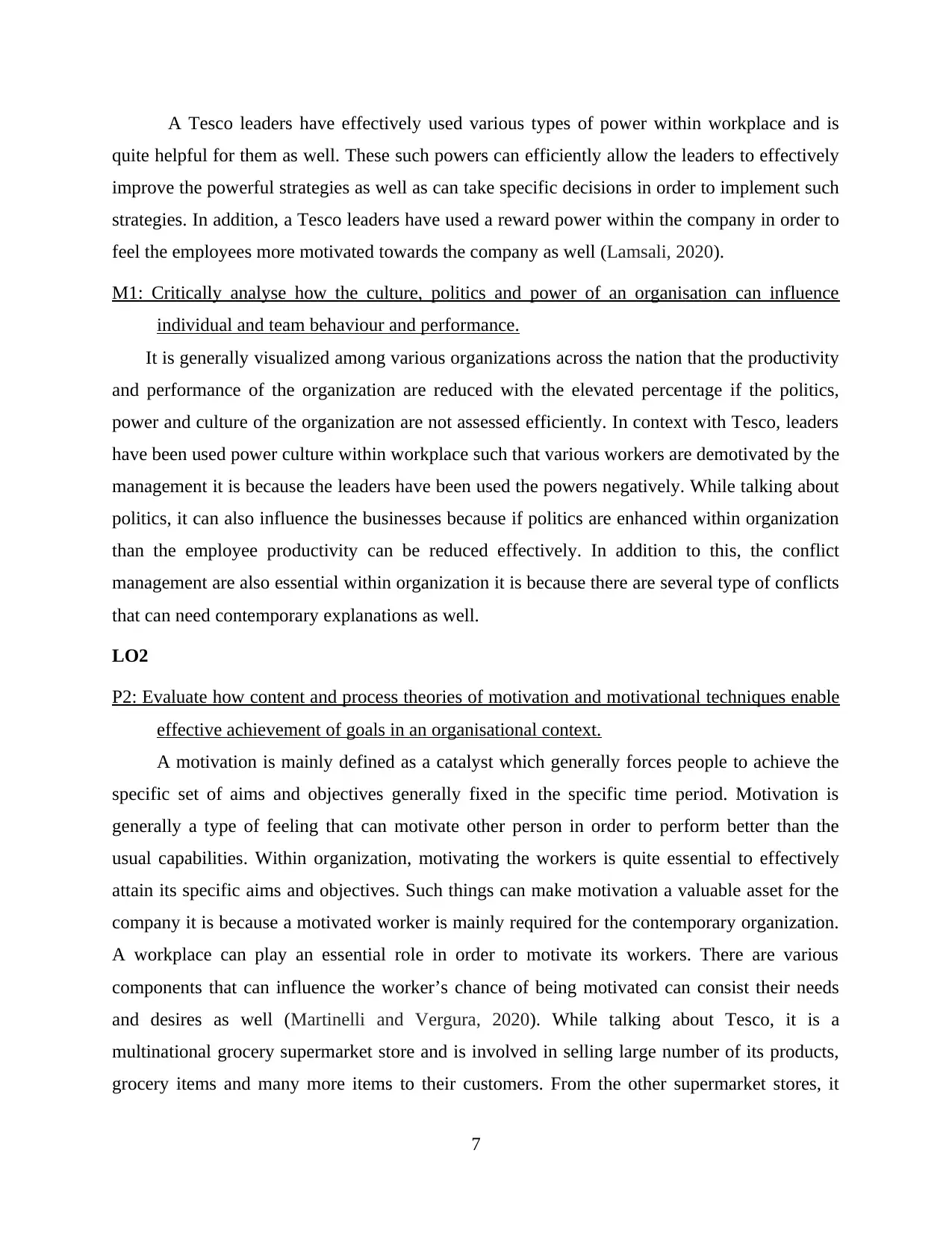
A Tesco leaders have effectively used various types of power within workplace and is
quite helpful for them as well. These such powers can efficiently allow the leaders to effectively
improve the powerful strategies as well as can take specific decisions in order to implement such
strategies. In addition, a Tesco leaders have used a reward power within the company in order to
feel the employees more motivated towards the company as well (Lamsali, 2020).
M1: Critically analyse how the culture, politics and power of an organisation can influence
individual and team behaviour and performance.
It is generally visualized among various organizations across the nation that the productivity
and performance of the organization are reduced with the elevated percentage if the politics,
power and culture of the organization are not assessed efficiently. In context with Tesco, leaders
have been used power culture within workplace such that various workers are demotivated by the
management it is because the leaders have been used the powers negatively. While talking about
politics, it can also influence the businesses because if politics are enhanced within organization
than the employee productivity can be reduced effectively. In addition to this, the conflict
management are also essential within organization it is because there are several type of conflicts
that can need contemporary explanations as well.
LO2
P2: Evaluate how content and process theories of motivation and motivational techniques enable
effective achievement of goals in an organisational context.
A motivation is mainly defined as a catalyst which generally forces people to achieve the
specific set of aims and objectives generally fixed in the specific time period. Motivation is
generally a type of feeling that can motivate other person in order to perform better than the
usual capabilities. Within organization, motivating the workers is quite essential to effectively
attain its specific aims and objectives. Such things can make motivation a valuable asset for the
company it is because a motivated worker is mainly required for the contemporary organization.
A workplace can play an essential role in order to motivate its workers. There are various
components that can influence the worker’s chance of being motivated can consist their needs
and desires as well (Martinelli and Vergura, 2020). While talking about Tesco, it is a
multinational grocery supermarket store and is involved in selling large number of its products,
grocery items and many more items to their customers. From the other supermarket stores, it
7
quite helpful for them as well. These such powers can efficiently allow the leaders to effectively
improve the powerful strategies as well as can take specific decisions in order to implement such
strategies. In addition, a Tesco leaders have used a reward power within the company in order to
feel the employees more motivated towards the company as well (Lamsali, 2020).
M1: Critically analyse how the culture, politics and power of an organisation can influence
individual and team behaviour and performance.
It is generally visualized among various organizations across the nation that the productivity
and performance of the organization are reduced with the elevated percentage if the politics,
power and culture of the organization are not assessed efficiently. In context with Tesco, leaders
have been used power culture within workplace such that various workers are demotivated by the
management it is because the leaders have been used the powers negatively. While talking about
politics, it can also influence the businesses because if politics are enhanced within organization
than the employee productivity can be reduced effectively. In addition to this, the conflict
management are also essential within organization it is because there are several type of conflicts
that can need contemporary explanations as well.
LO2
P2: Evaluate how content and process theories of motivation and motivational techniques enable
effective achievement of goals in an organisational context.
A motivation is mainly defined as a catalyst which generally forces people to achieve the
specific set of aims and objectives generally fixed in the specific time period. Motivation is
generally a type of feeling that can motivate other person in order to perform better than the
usual capabilities. Within organization, motivating the workers is quite essential to effectively
attain its specific aims and objectives. Such things can make motivation a valuable asset for the
company it is because a motivated worker is mainly required for the contemporary organization.
A workplace can play an essential role in order to motivate its workers. There are various
components that can influence the worker’s chance of being motivated can consist their needs
and desires as well (Martinelli and Vergura, 2020). While talking about Tesco, it is a
multinational grocery supermarket store and is involved in selling large number of its products,
grocery items and many more items to their customers. From the other supermarket stores, it
7
Paraphrase This Document
Need a fresh take? Get an instant paraphrase of this document with our AI Paraphraser
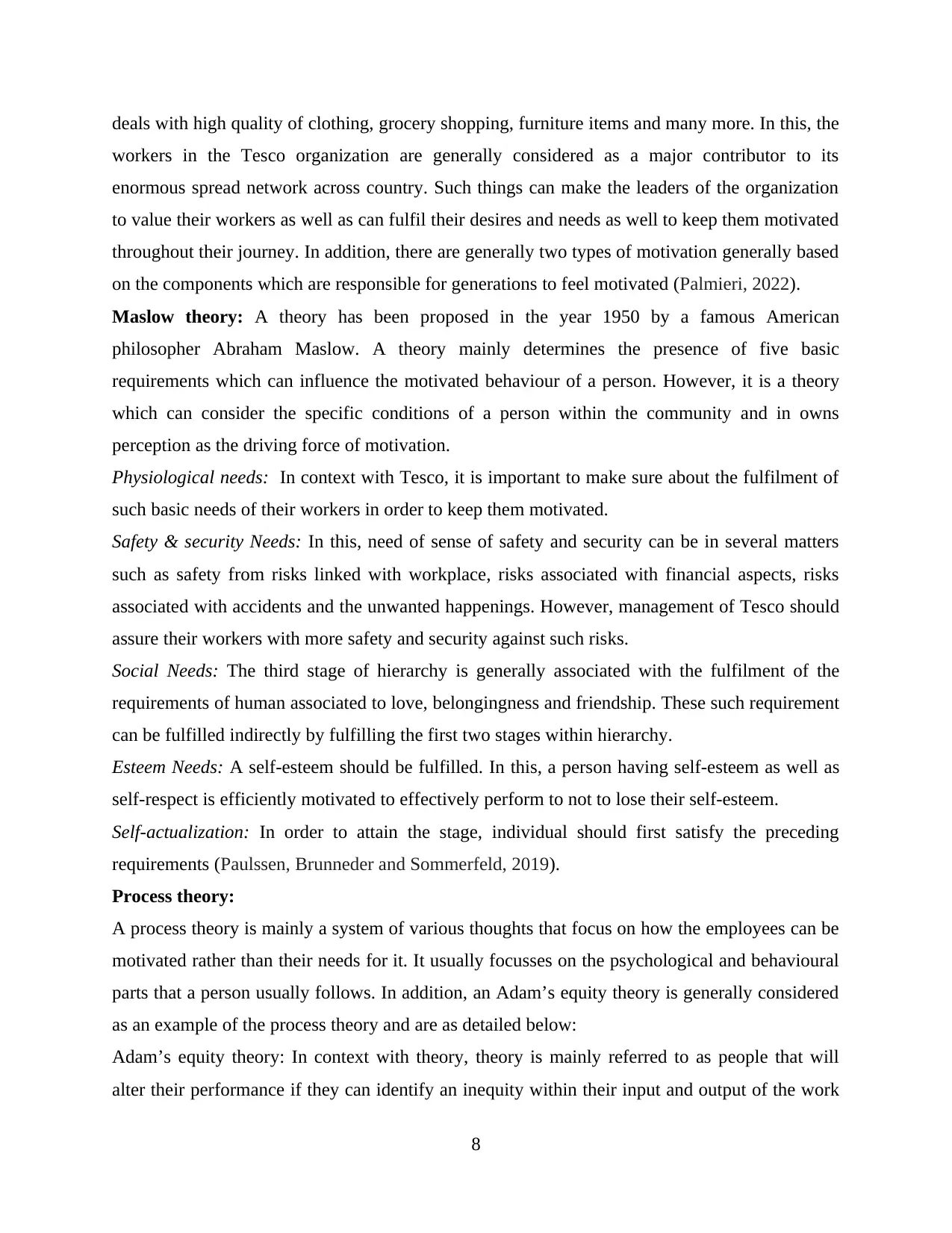
deals with high quality of clothing, grocery shopping, furniture items and many more. In this, the
workers in the Tesco organization are generally considered as a major contributor to its
enormous spread network across country. Such things can make the leaders of the organization
to value their workers as well as can fulfil their desires and needs as well to keep them motivated
throughout their journey. In addition, there are generally two types of motivation generally based
on the components which are responsible for generations to feel motivated (Palmieri, 2022).
Maslow theory: A theory has been proposed in the year 1950 by a famous American
philosopher Abraham Maslow. A theory mainly determines the presence of five basic
requirements which can influence the motivated behaviour of a person. However, it is a theory
which can consider the specific conditions of a person within the community and in owns
perception as the driving force of motivation.
Physiological needs: In context with Tesco, it is important to make sure about the fulfilment of
such basic needs of their workers in order to keep them motivated.
Safety & security Needs: In this, need of sense of safety and security can be in several matters
such as safety from risks linked with workplace, risks associated with financial aspects, risks
associated with accidents and the unwanted happenings. However, management of Tesco should
assure their workers with more safety and security against such risks.
Social Needs: The third stage of hierarchy is generally associated with the fulfilment of the
requirements of human associated to love, belongingness and friendship. These such requirement
can be fulfilled indirectly by fulfilling the first two stages within hierarchy.
Esteem Needs: A self-esteem should be fulfilled. In this, a person having self-esteem as well as
self-respect is efficiently motivated to effectively perform to not to lose their self-esteem.
Self-actualization: In order to attain the stage, individual should first satisfy the preceding
requirements (Paulssen, Brunneder and Sommerfeld, 2019).
Process theory:
A process theory is mainly a system of various thoughts that focus on how the employees can be
motivated rather than their needs for it. It usually focusses on the psychological and behavioural
parts that a person usually follows. In addition, an Adam’s equity theory is generally considered
as an example of the process theory and are as detailed below:
Adam’s equity theory: In context with theory, theory is mainly referred to as people that will
alter their performance if they can identify an inequity within their input and output of the work
8
workers in the Tesco organization are generally considered as a major contributor to its
enormous spread network across country. Such things can make the leaders of the organization
to value their workers as well as can fulfil their desires and needs as well to keep them motivated
throughout their journey. In addition, there are generally two types of motivation generally based
on the components which are responsible for generations to feel motivated (Palmieri, 2022).
Maslow theory: A theory has been proposed in the year 1950 by a famous American
philosopher Abraham Maslow. A theory mainly determines the presence of five basic
requirements which can influence the motivated behaviour of a person. However, it is a theory
which can consider the specific conditions of a person within the community and in owns
perception as the driving force of motivation.
Physiological needs: In context with Tesco, it is important to make sure about the fulfilment of
such basic needs of their workers in order to keep them motivated.
Safety & security Needs: In this, need of sense of safety and security can be in several matters
such as safety from risks linked with workplace, risks associated with financial aspects, risks
associated with accidents and the unwanted happenings. However, management of Tesco should
assure their workers with more safety and security against such risks.
Social Needs: The third stage of hierarchy is generally associated with the fulfilment of the
requirements of human associated to love, belongingness and friendship. These such requirement
can be fulfilled indirectly by fulfilling the first two stages within hierarchy.
Esteem Needs: A self-esteem should be fulfilled. In this, a person having self-esteem as well as
self-respect is efficiently motivated to effectively perform to not to lose their self-esteem.
Self-actualization: In order to attain the stage, individual should first satisfy the preceding
requirements (Paulssen, Brunneder and Sommerfeld, 2019).
Process theory:
A process theory is mainly a system of various thoughts that focus on how the employees can be
motivated rather than their needs for it. It usually focusses on the psychological and behavioural
parts that a person usually follows. In addition, an Adam’s equity theory is generally considered
as an example of the process theory and are as detailed below:
Adam’s equity theory: In context with theory, theory is mainly referred to as people that will
alter their performance if they can identify an inequity within their input and output of the work
8
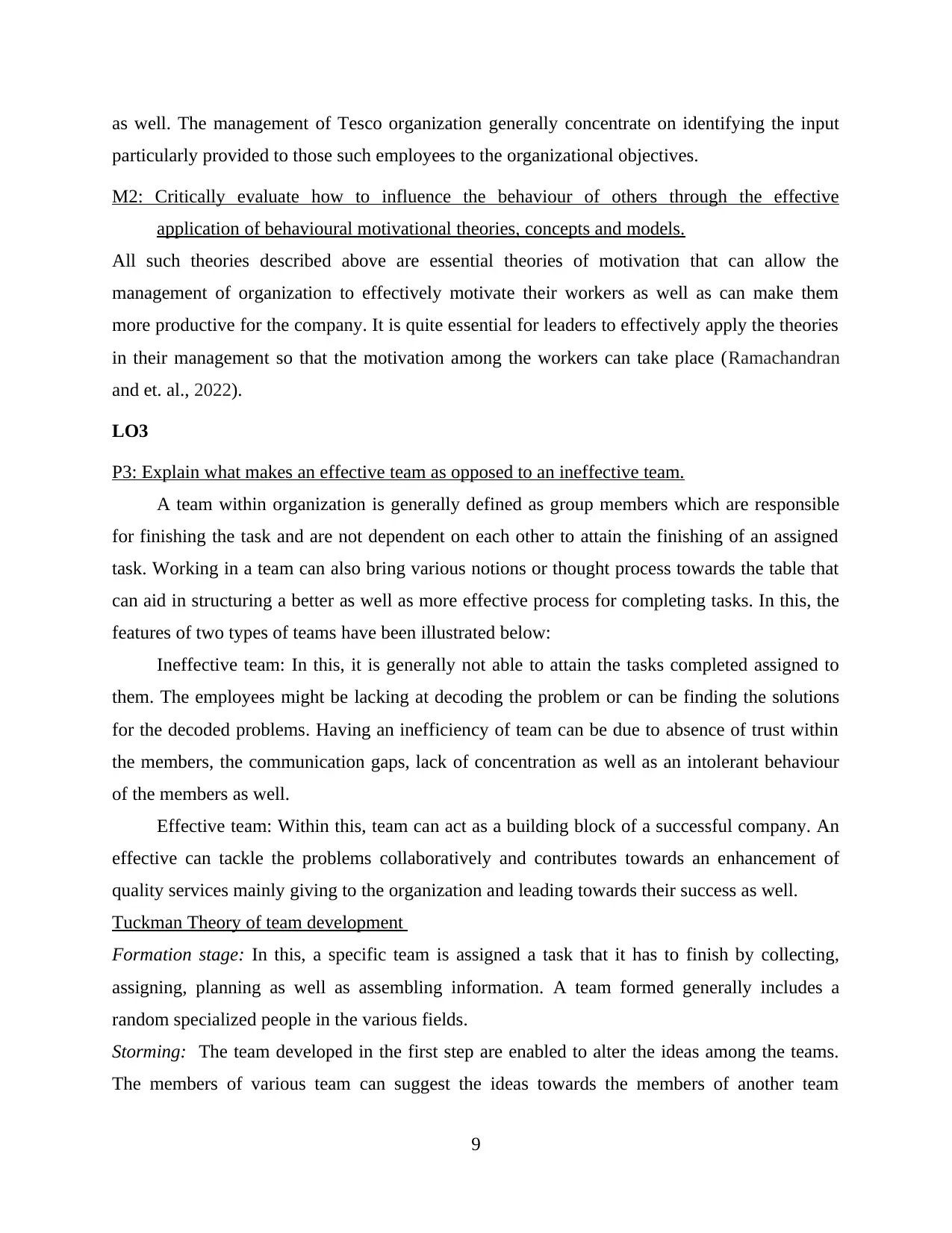
as well. The management of Tesco organization generally concentrate on identifying the input
particularly provided to those such employees to the organizational objectives.
M2: Critically evaluate how to influence the behaviour of others through the effective
application of behavioural motivational theories, concepts and models.
All such theories described above are essential theories of motivation that can allow the
management of organization to effectively motivate their workers as well as can make them
more productive for the company. It is quite essential for leaders to effectively apply the theories
in their management so that the motivation among the workers can take place (Ramachandran
and et. al., 2022).
LO3
P3: Explain what makes an effective team as opposed to an ineffective team.
A team within organization is generally defined as group members which are responsible
for finishing the task and are not dependent on each other to attain the finishing of an assigned
task. Working in a team can also bring various notions or thought process towards the table that
can aid in structuring a better as well as more effective process for completing tasks. In this, the
features of two types of teams have been illustrated below:
Ineffective team: In this, it is generally not able to attain the tasks completed assigned to
them. The employees might be lacking at decoding the problem or can be finding the solutions
for the decoded problems. Having an inefficiency of team can be due to absence of trust within
the members, the communication gaps, lack of concentration as well as an intolerant behaviour
of the members as well.
Effective team: Within this, team can act as a building block of a successful company. An
effective can tackle the problems collaboratively and contributes towards an enhancement of
quality services mainly giving to the organization and leading towards their success as well.
Tuckman Theory of team development
Formation stage: In this, a specific team is assigned a task that it has to finish by collecting,
assigning, planning as well as assembling information. A team formed generally includes a
random specialized people in the various fields.
Storming: The team developed in the first step are enabled to alter the ideas among the teams.
The members of various team can suggest the ideas towards the members of another team
9
particularly provided to those such employees to the organizational objectives.
M2: Critically evaluate how to influence the behaviour of others through the effective
application of behavioural motivational theories, concepts and models.
All such theories described above are essential theories of motivation that can allow the
management of organization to effectively motivate their workers as well as can make them
more productive for the company. It is quite essential for leaders to effectively apply the theories
in their management so that the motivation among the workers can take place (Ramachandran
and et. al., 2022).
LO3
P3: Explain what makes an effective team as opposed to an ineffective team.
A team within organization is generally defined as group members which are responsible
for finishing the task and are not dependent on each other to attain the finishing of an assigned
task. Working in a team can also bring various notions or thought process towards the table that
can aid in structuring a better as well as more effective process for completing tasks. In this, the
features of two types of teams have been illustrated below:
Ineffective team: In this, it is generally not able to attain the tasks completed assigned to
them. The employees might be lacking at decoding the problem or can be finding the solutions
for the decoded problems. Having an inefficiency of team can be due to absence of trust within
the members, the communication gaps, lack of concentration as well as an intolerant behaviour
of the members as well.
Effective team: Within this, team can act as a building block of a successful company. An
effective can tackle the problems collaboratively and contributes towards an enhancement of
quality services mainly giving to the organization and leading towards their success as well.
Tuckman Theory of team development
Formation stage: In this, a specific team is assigned a task that it has to finish by collecting,
assigning, planning as well as assembling information. A team formed generally includes a
random specialized people in the various fields.
Storming: The team developed in the first step are enabled to alter the ideas among the teams.
The members of various team can suggest the ideas towards the members of another team
9
⊘ This is a preview!⊘
Do you want full access?
Subscribe today to unlock all pages.

Trusted by 1+ million students worldwide
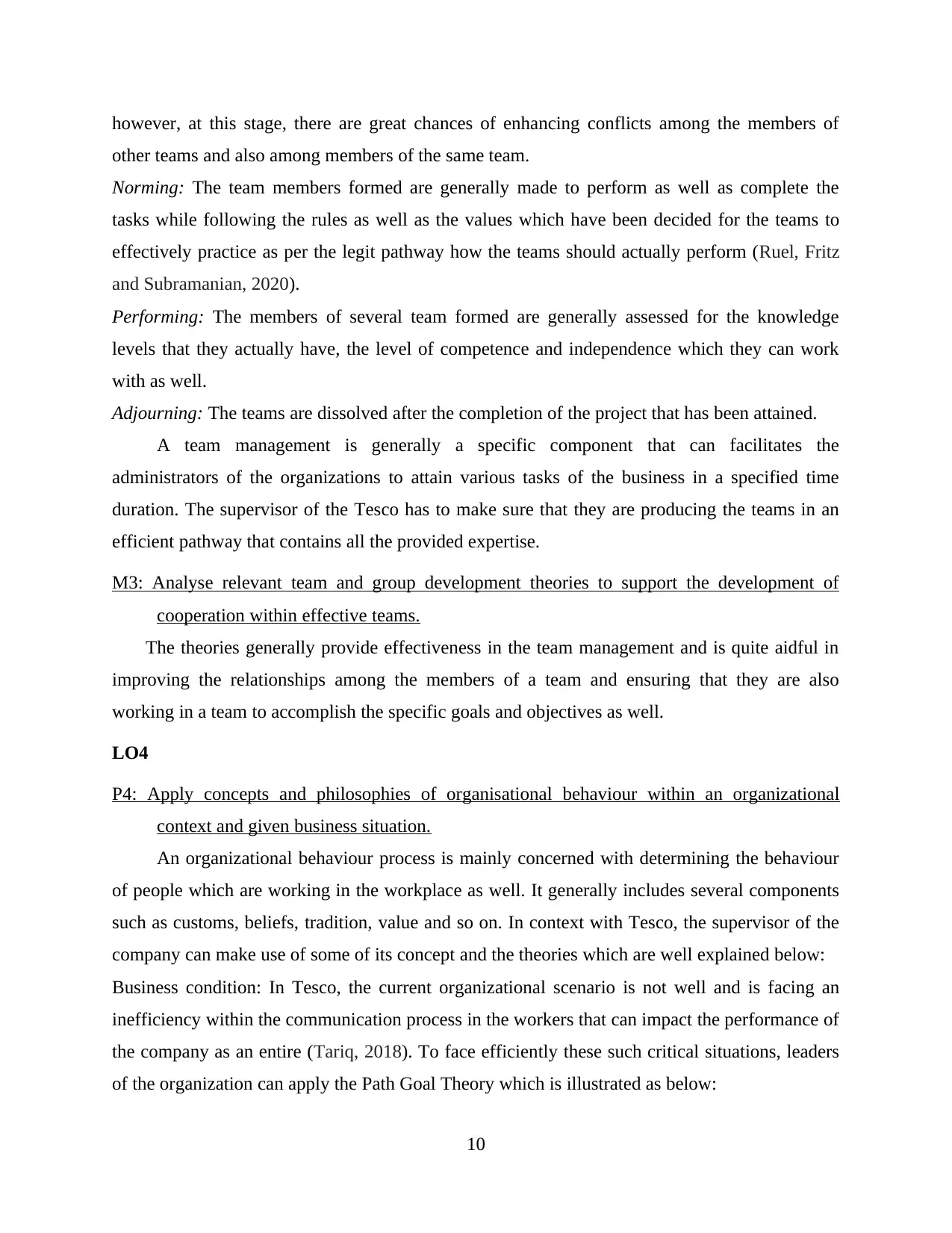
however, at this stage, there are great chances of enhancing conflicts among the members of
other teams and also among members of the same team.
Norming: The team members formed are generally made to perform as well as complete the
tasks while following the rules as well as the values which have been decided for the teams to
effectively practice as per the legit pathway how the teams should actually perform (Ruel, Fritz
and Subramanian, 2020).
Performing: The members of several team formed are generally assessed for the knowledge
levels that they actually have, the level of competence and independence which they can work
with as well.
Adjourning: The teams are dissolved after the completion of the project that has been attained.
A team management is generally a specific component that can facilitates the
administrators of the organizations to attain various tasks of the business in a specified time
duration. The supervisor of the Tesco has to make sure that they are producing the teams in an
efficient pathway that contains all the provided expertise.
M3: Analyse relevant team and group development theories to support the development of
cooperation within effective teams.
The theories generally provide effectiveness in the team management and is quite aidful in
improving the relationships among the members of a team and ensuring that they are also
working in a team to accomplish the specific goals and objectives as well.
LO4
P4: Apply concepts and philosophies of organisational behaviour within an organizational
context and given business situation.
An organizational behaviour process is mainly concerned with determining the behaviour
of people which are working in the workplace as well. It generally includes several components
such as customs, beliefs, tradition, value and so on. In context with Tesco, the supervisor of the
company can make use of some of its concept and the theories which are well explained below:
Business condition: In Tesco, the current organizational scenario is not well and is facing an
inefficiency within the communication process in the workers that can impact the performance of
the company as an entire (Tariq, 2018). To face efficiently these such critical situations, leaders
of the organization can apply the Path Goal Theory which is illustrated as below:
10
other teams and also among members of the same team.
Norming: The team members formed are generally made to perform as well as complete the
tasks while following the rules as well as the values which have been decided for the teams to
effectively practice as per the legit pathway how the teams should actually perform (Ruel, Fritz
and Subramanian, 2020).
Performing: The members of several team formed are generally assessed for the knowledge
levels that they actually have, the level of competence and independence which they can work
with as well.
Adjourning: The teams are dissolved after the completion of the project that has been attained.
A team management is generally a specific component that can facilitates the
administrators of the organizations to attain various tasks of the business in a specified time
duration. The supervisor of the Tesco has to make sure that they are producing the teams in an
efficient pathway that contains all the provided expertise.
M3: Analyse relevant team and group development theories to support the development of
cooperation within effective teams.
The theories generally provide effectiveness in the team management and is quite aidful in
improving the relationships among the members of a team and ensuring that they are also
working in a team to accomplish the specific goals and objectives as well.
LO4
P4: Apply concepts and philosophies of organisational behaviour within an organizational
context and given business situation.
An organizational behaviour process is mainly concerned with determining the behaviour
of people which are working in the workplace as well. It generally includes several components
such as customs, beliefs, tradition, value and so on. In context with Tesco, the supervisor of the
company can make use of some of its concept and the theories which are well explained below:
Business condition: In Tesco, the current organizational scenario is not well and is facing an
inefficiency within the communication process in the workers that can impact the performance of
the company as an entire (Tariq, 2018). To face efficiently these such critical situations, leaders
of the organization can apply the Path Goal Theory which is illustrated as below:
10
Paraphrase This Document
Need a fresh take? Get an instant paraphrase of this document with our AI Paraphraser
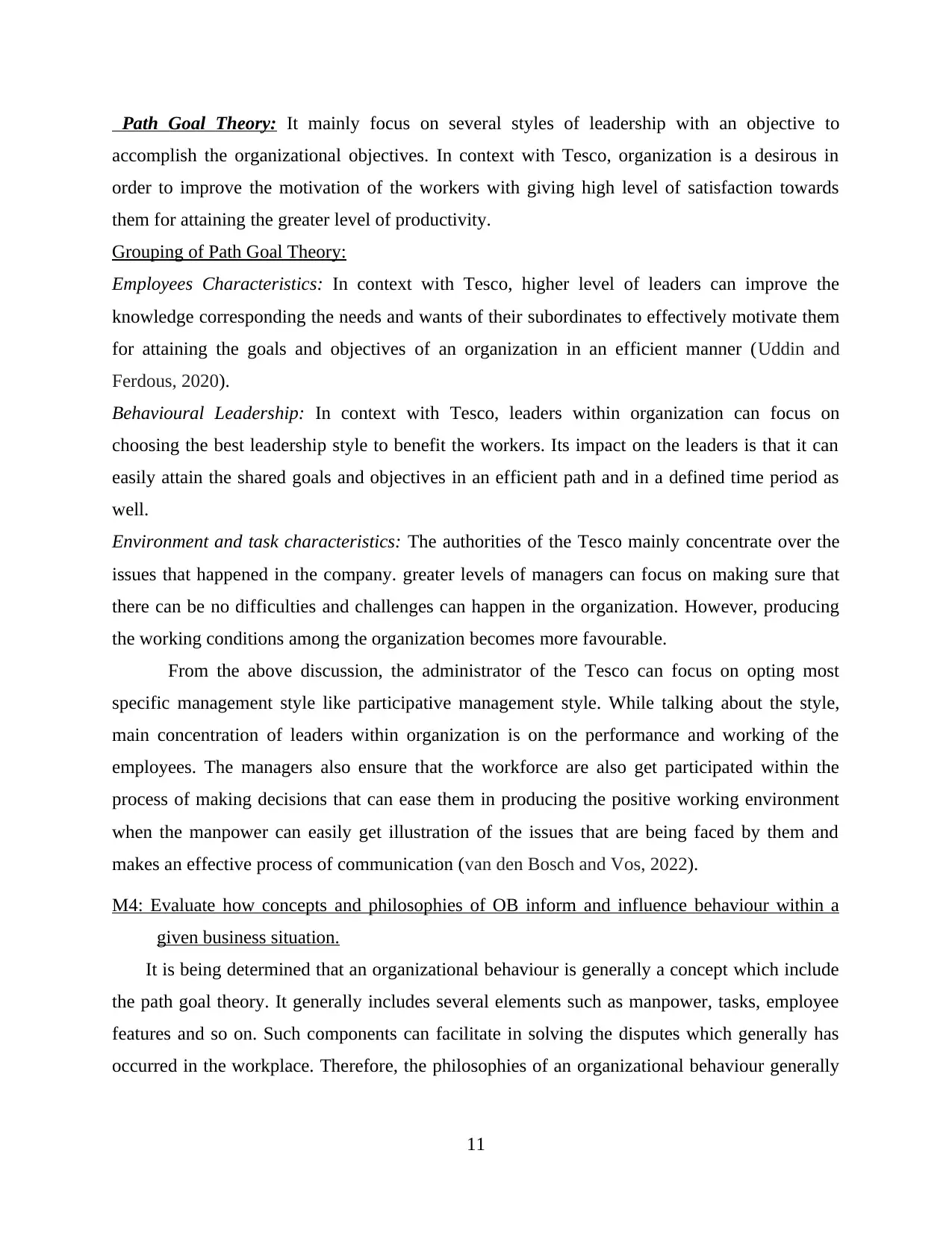
Path Goal Theory: It mainly focus on several styles of leadership with an objective to
accomplish the organizational objectives. In context with Tesco, organization is a desirous in
order to improve the motivation of the workers with giving high level of satisfaction towards
them for attaining the greater level of productivity.
Grouping of Path Goal Theory:
Employees Characteristics: In context with Tesco, higher level of leaders can improve the
knowledge corresponding the needs and wants of their subordinates to effectively motivate them
for attaining the goals and objectives of an organization in an efficient manner (Uddin and
Ferdous, 2020).
Behavioural Leadership: In context with Tesco, leaders within organization can focus on
choosing the best leadership style to benefit the workers. Its impact on the leaders is that it can
easily attain the shared goals and objectives in an efficient path and in a defined time period as
well.
Environment and task characteristics: The authorities of the Tesco mainly concentrate over the
issues that happened in the company. greater levels of managers can focus on making sure that
there can be no difficulties and challenges can happen in the organization. However, producing
the working conditions among the organization becomes more favourable.
From the above discussion, the administrator of the Tesco can focus on opting most
specific management style like participative management style. While talking about the style,
main concentration of leaders within organization is on the performance and working of the
employees. The managers also ensure that the workforce are also get participated within the
process of making decisions that can ease them in producing the positive working environment
when the manpower can easily get illustration of the issues that are being faced by them and
makes an effective process of communication (van den Bosch and Vos, 2022).
M4: Evaluate how concepts and philosophies of OB inform and influence behaviour within a
given business situation.
It is being determined that an organizational behaviour is generally a concept which include
the path goal theory. It generally includes several elements such as manpower, tasks, employee
features and so on. Such components can facilitate in solving the disputes which generally has
occurred in the workplace. Therefore, the philosophies of an organizational behaviour generally
11
accomplish the organizational objectives. In context with Tesco, organization is a desirous in
order to improve the motivation of the workers with giving high level of satisfaction towards
them for attaining the greater level of productivity.
Grouping of Path Goal Theory:
Employees Characteristics: In context with Tesco, higher level of leaders can improve the
knowledge corresponding the needs and wants of their subordinates to effectively motivate them
for attaining the goals and objectives of an organization in an efficient manner (Uddin and
Ferdous, 2020).
Behavioural Leadership: In context with Tesco, leaders within organization can focus on
choosing the best leadership style to benefit the workers. Its impact on the leaders is that it can
easily attain the shared goals and objectives in an efficient path and in a defined time period as
well.
Environment and task characteristics: The authorities of the Tesco mainly concentrate over the
issues that happened in the company. greater levels of managers can focus on making sure that
there can be no difficulties and challenges can happen in the organization. However, producing
the working conditions among the organization becomes more favourable.
From the above discussion, the administrator of the Tesco can focus on opting most
specific management style like participative management style. While talking about the style,
main concentration of leaders within organization is on the performance and working of the
employees. The managers also ensure that the workforce are also get participated within the
process of making decisions that can ease them in producing the positive working environment
when the manpower can easily get illustration of the issues that are being faced by them and
makes an effective process of communication (van den Bosch and Vos, 2022).
M4: Evaluate how concepts and philosophies of OB inform and influence behaviour within a
given business situation.
It is being determined that an organizational behaviour is generally a concept which include
the path goal theory. It generally includes several elements such as manpower, tasks, employee
features and so on. Such components can facilitate in solving the disputes which generally has
occurred in the workplace. Therefore, the philosophies of an organizational behaviour generally
11
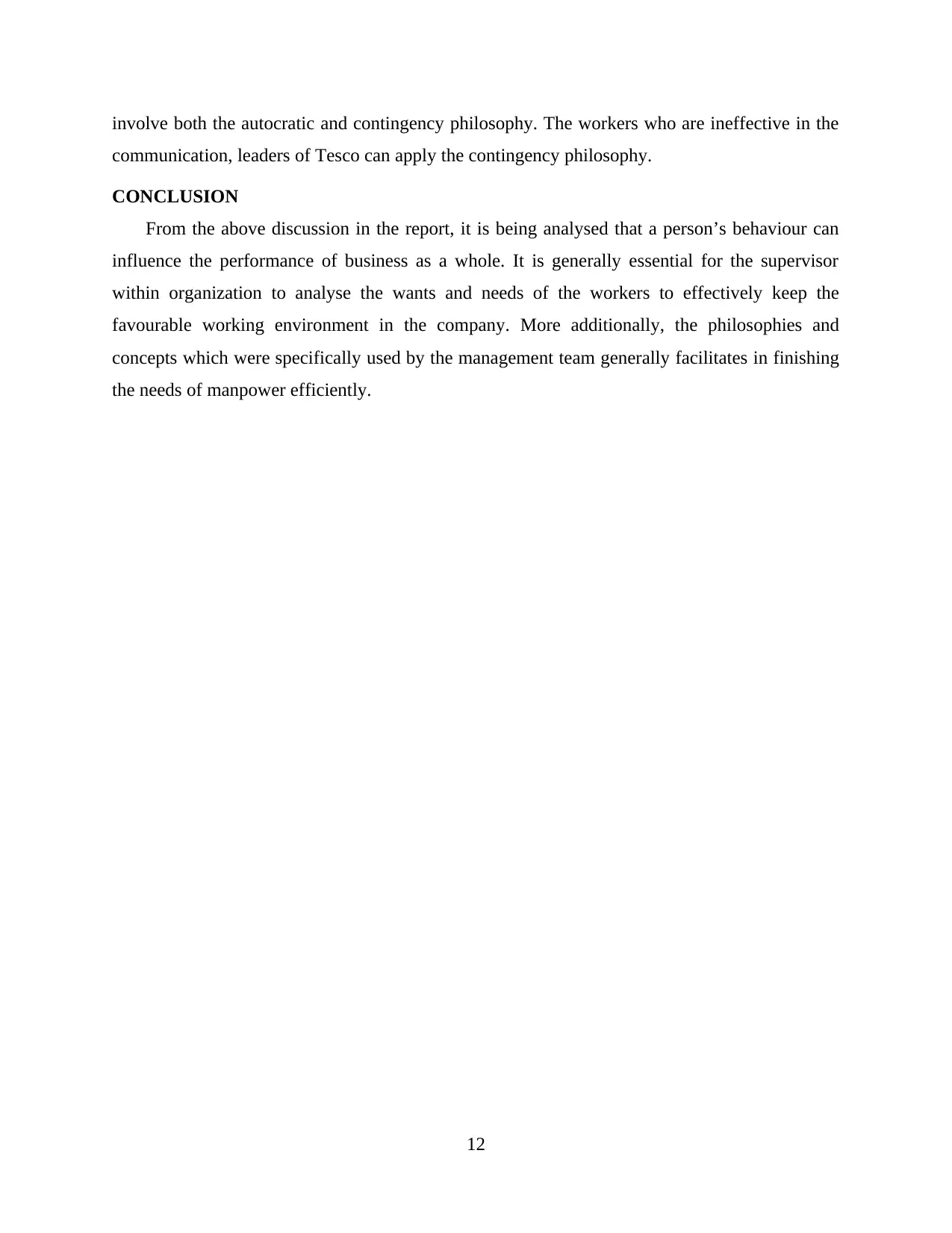
involve both the autocratic and contingency philosophy. The workers who are ineffective in the
communication, leaders of Tesco can apply the contingency philosophy.
CONCLUSION
From the above discussion in the report, it is being analysed that a person’s behaviour can
influence the performance of business as a whole. It is generally essential for the supervisor
within organization to analyse the wants and needs of the workers to effectively keep the
favourable working environment in the company. More additionally, the philosophies and
concepts which were specifically used by the management team generally facilitates in finishing
the needs of manpower efficiently.
12
communication, leaders of Tesco can apply the contingency philosophy.
CONCLUSION
From the above discussion in the report, it is being analysed that a person’s behaviour can
influence the performance of business as a whole. It is generally essential for the supervisor
within organization to analyse the wants and needs of the workers to effectively keep the
favourable working environment in the company. More additionally, the philosophies and
concepts which were specifically used by the management team generally facilitates in finishing
the needs of manpower efficiently.
12
⊘ This is a preview!⊘
Do you want full access?
Subscribe today to unlock all pages.

Trusted by 1+ million students worldwide
1 out of 14
Related Documents
Your All-in-One AI-Powered Toolkit for Academic Success.
+13062052269
info@desklib.com
Available 24*7 on WhatsApp / Email
![[object Object]](/_next/static/media/star-bottom.7253800d.svg)
Unlock your academic potential
Copyright © 2020–2025 A2Z Services. All Rights Reserved. Developed and managed by ZUCOL.



